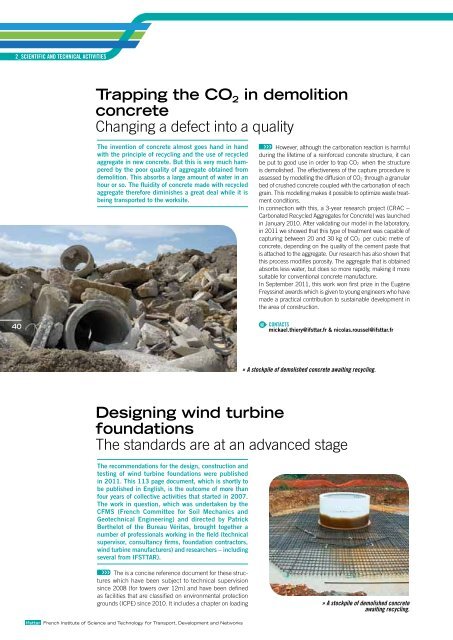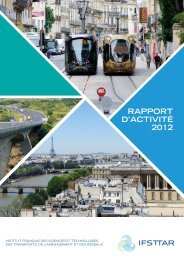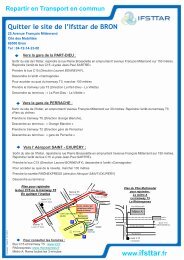french institute of science and technology for transport ... - Ifsttar
french institute of science and technology for transport ... - Ifsttar
french institute of science and technology for transport ... - Ifsttar
Create successful ePaper yourself
Turn your PDF publications into a flip-book with our unique Google optimized e-Paper software.
2_SCIENTIFIC AND TECHNICAL ACTIVITIES<br />
Trapping the CO 2 in demolition<br />
concrete<br />
Changing a defect into a quality<br />
The invention <strong>of</strong> concrete almost goes h<strong>and</strong> in h<strong>and</strong><br />
with the principle <strong>of</strong> recycling <strong>and</strong> the use <strong>of</strong> recycled<br />
aggregate in new concrete. But this is very much hampered<br />
by the poor quality <strong>of</strong> aggregate obtained from<br />
demolition. This absorbs a large amount <strong>of</strong> water in an<br />
hour or so. The fluidity <strong>of</strong> concrete made with recycled<br />
aggregate there<strong>for</strong>e diminishes a great deal while it is<br />
being <strong>transport</strong>ed to the worksite.<br />
However, although the carbonation reaction is harmful<br />
during the lifetime <strong>of</strong> a rein<strong>for</strong>ced concrete structure, it can<br />
be put to good use in order to trap CO 2 when the structure<br />
is demolished. The effectiveness <strong>of</strong> the capture procedure is<br />
assessed by modelling the diffusion <strong>of</strong> CO 2 through a granular<br />
bed <strong>of</strong> crushed concrete coupled with the carbonation <strong>of</strong> each<br />
grain. This modelling makes it possible to optimize waste treatment<br />
conditions.<br />
In connection with this, a 3-year research project (CRAC −<br />
Carbonated Recycled Aggregates <strong>for</strong> Concrete) was launched<br />
in January 2010. After validating our model in the laboratory,<br />
in 2011 we showed that this type <strong>of</strong> treatment was capable <strong>of</strong><br />
capturing between 20 <strong>and</strong> 30 kg <strong>of</strong> CO 2 per cubic metre <strong>of</strong><br />
concrete, depending on the quality <strong>of</strong> the cement paste that<br />
is attached to the aggregate. Our research has also shown that<br />
this process modifies porosity. The aggregate that is obtained<br />
absorbs less water, but does so more rapidly, making it more<br />
suitable <strong>for</strong> conventional concrete manufacture.<br />
In September 2011, this work won first prize in the Eugène<br />
Freyssinet awards which is given to young engineers who have<br />
made a practical contribution to sustainable development in<br />
the area <strong>of</strong> construction.<br />
40<br />
@ CONTACTS<br />
mickael.thiery@ifsttar.fr & nicolas.roussel@ifsttar.fr<br />
A stockpile <strong>of</strong> demolished concrete awaiting recycling.<br />
Designing wind turbine<br />
foundations<br />
The st<strong>and</strong>ards are at an advanced stage<br />
The recommendations <strong>for</strong> the design, construction <strong>and</strong><br />
testing <strong>of</strong> wind turbine foundations were published<br />
in 2011. This 113 page document, which is shortly to<br />
be published in English, is the outcome <strong>of</strong> more than<br />
four years <strong>of</strong> collective activities that started in 2007.<br />
The work in question, which was undertaken by the<br />
CFMS (French Committee <strong>for</strong> Soil Mechanics <strong>and</strong><br />
Geotechnical Engineering) <strong>and</strong> directed by Patrick<br />
Berthelot <strong>of</strong> the Bureau Véritas, brought together a<br />
number <strong>of</strong> pr<strong>of</strong>essionals working in the field (technical<br />
supervisor, consultancy firms, foundation contractors,<br />
wind turbine manufacturers) <strong>and</strong> researchers – including<br />
several from IFSTTAR).<br />
The is a concise reference document <strong>for</strong> these structures<br />
which have been subject to technical supervision<br />
since 2008 (<strong>for</strong> towers over 12m) <strong>and</strong> have been defined<br />
as facilities that are classified on environmental protection<br />
grounds (ICPE) since 2010. It includes a chapter on loading<br />
A stockpile <strong>of</strong> demolished concrete<br />
awaiting recycling.<br />
ifsttar French Institute <strong>of</strong> Science <strong>and</strong> Technology <strong>for</strong> Transport, Development <strong>and</strong> Networks






![Trajectoire le magazine n°3 - Juillet 2012 [.pdf] - Ifsttar](https://img.yumpu.com/30038493/1/190x253/trajectoire-le-magazine-na3-juillet-2012-pdf-ifsttar.jpg?quality=85)

